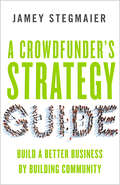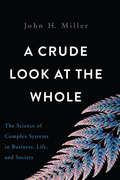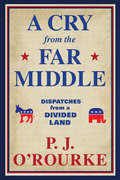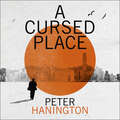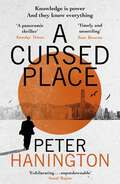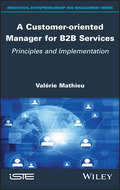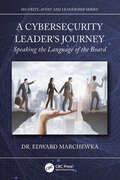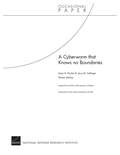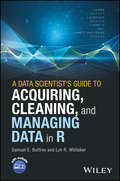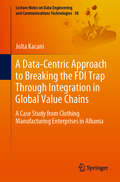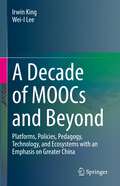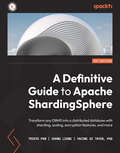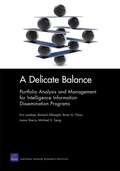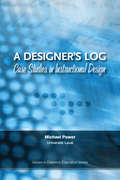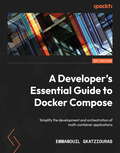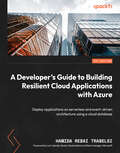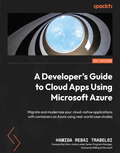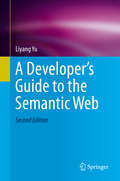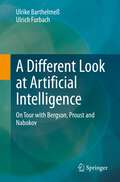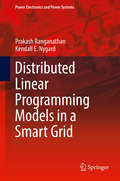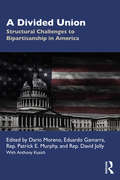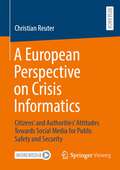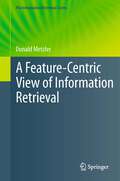- Table View
- List View
A Crowdfunder's Strategy Guide: Build a Better Business by Building Community
by Jamey StegmaierMore Than MoneyJamey Stegmaier knows crowdfunding. He's a veteran of seven successful Kickstarter campaigns (and counting) that have raised over $3.2 million, and he's the proprietor of the widely read Kickstarter Lessons blog. In this book he offers a comprehensive guide to crowdfunding, demonstrating that it can be a powerful way for entrepreneurs to grow their businesses by building community and putting their customers first.This book includes over forty stories of inspiring successes and sobering disasters. Stegmaier uses these examples to demonstrate how to (and how not to) prepare for a campaign, grow a fan base, structure a pitch, find new backers, and execute many other crucially important "nuts and bolts" elements of a successful crowdfunding project.But Stegmaier emphasizes that the benefits of crowdfunding are much more about the "crowd" than the "funding." He shows that if you treat your backers as people, not pocketbooks—communicate regularly and transparently with them, ask their opinions, attend to their needs—they'll become advocates as well as funders, exponentially increasing your project's chances of succeeding.
A Crude Look at the Whole: The Science of Complex Systems in Business, Life, and Society
by John H. MillerImagine trying to understand a stained glass window by breaking it into pieces and examining it one shard at a time. While you could probably learn a lot about each piece, you would have no idea about what the entire picture looks like. This is reductionism--the idea that to understand the world we only need to study its pieces--and it is how most social scientists approach their work. In A Crude Look at the Whole, social scientist and economist John H. Miller shows why we need to start looking at whole pictures. For one thing, whether we are talking about stock markets, computer networks, or biological organisms, individual parts only make sense when we remember that they are part of larger wholes. And perhaps more importantly, those wholes can take on behaviors that are strikingly different from that of their pieces. Miller, a leading expert in the computational study of complex adaptive systems, reveals astounding global patterns linking the organization of otherwise radically different structures: It might seem crude, but a beehive’s temperature control system can help predict market fluctuations and a mammal’s heartbeat can help us understand the "heartbeat” of a city and adapt urban planning accordingly. From enduring racial segregation to sudden stock market disasters, once we start drawing links between complex systems, we can start solving what otherwise might be totally intractable problems. Thanks to this revolutionary perspective, we can finally transcend the limits of reductionism and discover crucial new ideas. Scientifically founded and beautifully written, A Crude Look at the Whole is a powerful exploration of the challenges that we face as a society. As it reveals, taking the crude look might be the only way to truly see.
A Cry from the Far Middle: Dispatches from a Divided Land
by P.J. O'RourkeIn a time of chaos, the #1 New York Times-bestselling political humorist asks his fellow Americans to take it down a notch. Is there an upside to being woke (and unable to get back to sleep)? If we license dentists, why don&’t we license politicians? Is your juicer sending fake news to your FitBit about what&’s in your refrigerator? The legendary P.J. O&’Rourke addresses these questions and more in this hilarious new collection of essays about our nation&’s propensity for anger and perplexity, which includes such gems as &“An Inaugural Address I&’d Like to Hear&” (Ask not what your country can do for you, ask how I can get the hell out of here) and &“Sympathy vs. Empathy,&” which contemplates whether it&’s better to hold people&’s hands or bust into their heads. Also included is a handy quiz to find out where you stand on the Coastals-vs.-Heartlanders spectrum. From the author of Parliament of Whores, None of My Business, and other modern classics, this is a smart look at the current state of these United States, and a plea to everyone to take a deep breath, relax, and enjoy a few good laughs. &“To say that P. J. O&’Rourke is funny is like saying the Rocky Mountains are scenic—accurate but insufficient.&” —Chicago Tribune &“The funniest writer in America.&”—The Wall Street Journal
A Cryptography Primer
by Philip N. KleinCryptography has been employed in war and diplomacy from the time of Julius Caesar. In our Internet age, cryptography's most widespread application may be for commerce, from protecting the security of electronic transfers to guarding communication from industrial espionage. This accessible introduction for undergraduates explains the cryptographic protocols for achieving privacy of communication and the use of digital signatures for certifying the validity, integrity, and origin of a message, document, or program. Rather than offering a how-to on configuring web browsers and e-mail programs, the author provides a guide to the principles and elementary mathematics underlying modern cryptography, giving readers a look under the hood for security techniques and the reasons they are thought to be secure.
A Cursed Place: A page-turning thriller of the dark world of cyber surveillance (William Carver Novels)
by Peter HaningtonReporter William Carver comes up against Big Tech's manipulation and suppression of truth from the mines of Chile to the turbulent streets of Hong Kong.Knowledge is power. And they know everything.The tech company Public Square believes in 'doing well by doing good'. It's built a multi-billion dollar business on this philosophy and by getting to know what people want. They know a lot. But who else can access all that information and what are they planning to do with it?Reporter William Carver is an analogue man in a digital world. He isn't the most tech-savvy reporter, he's definitely old school, but he needs to learn fast - the people he cares most about are in harm's way.From the Chilean mines where they dig for raw materials that enable the tech revolution, to the streets of Hong Kong where anti-government protesters are fighting against the Chinese State, to the shiny research laboratories of Silicon Valley where personal data is being mined everyday - A Cursed Place is a gripping thriller set against the global forces that shape our times.(P) 2021 Hodder & Stoughton
A Cursed Place: A page-turning thriller of the dark world of cyber surveillance (William Carver Novels)
by Peter Hanington*ONE OF 40 BOOKS FOR SUMMER* 'gripping'- iNews'A panoramic thriller ...chockful of vivid characters.' - THE SUNDAY TIMES'An intriguing, timely and unsettling new thriller' - SAM BOURNE'Exhilarating and beautiful' - AMOL RAJAN'Catapults you from first word to last... pacy, sinister and timely read.' - ALAN JUDD'Another page-turner from a writer who can take you into gripping worlds, real and virtual.' MISHAL HUSAIN 'A terrific thriller - vivid, quick-witted and dynamic, crackling with energy, dread and rage as it crosses continents and digs down into the human heart.' - NICCI GERRARD 'The dark world of private cyber-surveillance crackles off the page - full of jeopardy and suspense.' - ALLAN LITTLE 'A vividly written thriller of ruthless tech entrepreneurs exploiting their surveillance powers and morally compromised journalists feeling their way in the dark towards the truth.' - RORY CELLAN-JONES'Carver is a marvellous creation.' - MIKE RIPLEY, SHOTS MAGKNOWLEDGE IS POWER. AND THEY KNOW EVERYTHING.The tech company Public Square believes in 'doing well by doing good'. It's built a multi-billion dollar business on this philosophy and by getting to know what people want. They know a lot. But who else can access all that information and what are they planning to do with it?Reporter William Carver is an analogue man in a digital world. He isn't the most tech-savvy reporter, he's definitely old school, but he needs to learn fast - the people he cares most about are in harm's way.From the Chilean mines where they dig for raw materials that enable the tech revolution, to the streets of Hong Kong where anti-government protesters are fighting against the Chinese State, to the shiny research laboratories of Silicon Valley where personal data is being mined everyday - A Cursed Place is a gripping thriller set against the global forces that shape our times.'A true page turner - highly recommended'. TORTOISE
A Customer-oriented Manager for B2B Services: Principles and Implementation
by Valerie MathieuThe notion of customer orientation is becoming a necessity rather than a choice for many companies. It is a lasting response to competitive pressure and supports the company in a renewed definition of its mission, beyond direct economic gain. Within B2B services, the manager, through proximity to their team, their market and their client, is the essential actor in the deployment of this orientation.A Customer-oriented Manager for B2B Services provides managers with the knowledge and tools necessary to implement customer orientation themselves, with the involvement of their extended team. To this end, this book presents a four-step approach: understand the fundamentals of customer orientation in B2B services, know the customer, make the most of the offer and deliver the service.
A Cybersecurity Leader's Journey: Speaking the Language of the Board (Security, Audit and Leadership Series)
by Edward MarchewkaIn today’s cybersecurity landscape, the role of a cybersecurity leader goes beyond technical expertise. Communicating cybersecurity risks and initiatives to executives and boards demands a unique blend of strategic insight and business language. A Cybersecurity Leader’s Journey: Speaking the Language of the Board takes readers on a transformative path from technical talk to business-savvy communication.Follow Nick, a newly appointed CISO, as he navigates the challenges of bridging the gap between complex cybersecurity concepts and the business-focused concerns of board members. Struggling to convey the impact of cybersecurity initiatives, Nick quickly realizes that his technical knowledge alone isn’t enough to gain the board’s trust. With guidance from a mentor, he learns how to address the board’s priorities, answer the critical question of “What’s in it for me?”, and deliver insights that resonate.This book offers more than just a narrative—it provides actionable takeaways for cybersecurity leaders and other professionals who want to master the art of strategic communication. Readers will discover how to close information asymmetry gaps, manage the affect heuristic, and develop a communication style that builds trust and fosters informed decision-making.Whether you’re a CISO, an aspiring CISO, or a technical expert aiming to improve your business communication, A Cybersecurity Leader’s Journey equips you with the skills to make cybersecurity not just a necessity but a valued component of business success as well. Step into Nick’s journey, gain insights from his challenges, and learn how to become the trusted advisor your board needs.
A Cyberworm that Knows no Boundaries
by Jerry M. Sollinger Isaac R. Porche III Shawn MckayIt has become clear that Stuxnet-like worms pose a serious threat even to critical U.S. infrastructure and computer systems that are not connected to the Internet. However, defending against such attacks involves complex technological and legal issues. In particular, at the federal level, different organizations have different responsibilities and levels of authority when it comes to investigating or defending against intrusions.
A Data Scientist's Guide to Acquiring, Cleaning, and Managing Data in R
by Samuel E. Buttrey Lyn R. WhitakerThe only how-to guide offering a unified, systemic approach to acquiring, cleaning, and managing data in R Every experienced practitioner knows that preparing data for modeling is a painstaking, time-consuming process. Adding to the difficulty is that most modelers learn the steps involved in cleaning and managing data piecemeal, often on the fly, or they develop their own ad hoc methods. This book helps simplify their task by providing a unified, systematic approach to acquiring, modeling, manipulating, cleaning, and maintaining data in R. Starting with the very basics, data scientists Samuel E. Buttrey and Lyn R. Whitaker walk readers through the entire process. From what data looks like and what it should look like, they progress through all the steps involved in getting data ready for modeling. They describe best practices for acquiring data from numerous sources; explore key issues in data handling, including text/regular expressions, big data, parallel processing, merging, matching, and checking for duplicates; and outline highly efficient and reliable techniques for documenting data and recordkeeping, including audit trails, getting data back out of R, and more. The only single-source guide to R data and its preparation, it describes best practices for acquiring, manipulating, cleaning, and maintaining data Begins with the basics and walks readers through all the steps necessary to get data ready for the modeling process Provides expert guidance on how to document the processes described so that they are reproducible Written by seasoned professionals, it provides both introductory and advanced techniques Features case studies with supporting data and R code, hosted on a companion website A Data Scientist's Guide to Acquiring, Cleaning and Managing Data in R is a valuable working resource/bench manual for practitioners who collect and analyze data, lab scientists and research associates of all levels of experience, and graduate-level data mining students.
A Data-Centric Approach to Breaking the FDI Trap Through Integration in Global Value Chains: A Case Study from Clothing Manufacturing Enterprises in Albania (Lecture Notes on Data Engineering and Communications Technologies #50)
by Jolta KacaniThis book reveals the hidden potential of emerging economies to become the new industrial hubs in existing global value chains. Pursuing a data-centric approach, it investigates the presence of foreign direct investment as an instrument for emerging economies to promote active participation in global value chains. This approach is based on time series analyses conducted at the national and industry level, and on datasets retrieved from international databases such as EORA, ICIO, and World Integrated Solutions. The outcomes of robust statistical models indicate that export-related innovations can improve trade openness and transform emerging economies into active players in global value chains. Researchers, developers, and professionals in the field will find a comprehensive and self-contained guide to the topic.
A Decade of MOOCs and Beyond: Platforms, Policies, Pedagogy, Technology, and Ecosystems with an Emphasis on Greater China
by Irwin King Wei-I LeeThis book is an academic publication about the global development of massive open online courses (MOOCs) and major MOOC platforms worldwide in the past decade, as well as the outlook of MOOCs in the future, with an emphasis on Greater China. The book also discusses the upsurge of the demand for online learning and MOOCs during the COVID-19 pandemic.The book is divided into three main parts - Part I: Overview of MOOCs introduces the origin and history of MOOCs and the development of MOOC platforms in Greater China and the global context; Part II: Key Issues discuss the MOOC policies, innovative pedagogy, technology, and ecosystems worldwide; and Part III: Beyond MOOCs probes into the roles and benefits of MOOCs in times of crises, as well as the outlook of MOOCs in the future. In terms of topic diversity, the book contains a comprehensive investigation of the past and latest MOOC developments, extracting and elaborating on relevant information regarding platforms, policies, pedagogy, technology, and ecosystems. Subsequently, in-depth analyses of MOOC data are utilized to deduce the current trends related to the MOOC movement and to extrapolate the likeliest direction of development for MOOCs in the years to come. The book can inform policymakers, education institutions, course instructors, platform developers, investors, researchers, and individual learners of MOOCs about critical information on the present and future of MOOC development, assisting them in making crucial decisions on what initiatives can optimize their advantages in the sector.
A Definitive Guide to Apache ShardingSphere: Transform any DBMS into a distributed database with sharding, scaling, encryption features, and more
by Trista Pan Zhang Liang Yacine Si TayebBecome well versed with all of ShardingSphere's features for every data management need with this comprehensive guide put together by ShardingSphere's founder and core contributorsKey FeaturesUnderstand the core concepts and efficiently set up Apache ShardingSphereEnhance existing databases with sharding, elastic scaling, encryption, governance features, and moreImport and customize the ecosystem's core features for various application scenariosBook DescriptionApache ShardingSphere is a new open source ecosystem for distributed data infrastructures based on pluggability and cloud-native principles that helps enhance your database.This book begins with a quick overview of the main challenges faced by database management systems (DBMSs) in production environments, followed by a brief introduction to the software's kernel concept. After that, using real-world examples of distributed database solutions, elastic scaling, DistSQL, synthetic monitoring, database gateways, and SQL authority and user authentication, you'll fully understand ShardingSphere's architectural components, how they're configured and can be plugged into your existing infrastructure, and how to manage your data and applications. You'll also explore ShardingSphere-JDBC and ShardingSphere-Proxy, the ecosystem's clients, and how they can work either concurrently or independently to address your needs. You'll then learn how to customize the plugin platform to define personalized user strategies and manage multiple configurations seamlessly. Finally, the book enables you to get up and running with functional and performance tests for all scenarios.By the end of this book, you'll be able to build and deploy a customized version of ShardingSphere, addressing the key pain points encountered in your data management infrastructure.What you will learnAssemble a custom solution using the software's pluggable architectureDiscover how to use Database Plus features effectivelyUnderstand the difference between ShardingSphere-JDBC and ShardingSphere-ProxyGet to grips with ShardingSphere's pluggability mechanismExplore mainstream test models for databases and distributed databasesPerform migrations from an on-premise database to a cloud-based databaseReconfigure your data infrastructure and eliminate switching costsWho this book is forThis book is for database administrators working with distributed database solutions who are looking to explore the capabilities of Apache ShardingSphere. DBAs looking for more capable, flexible, and cost-effective alternatives to the solutions they're currently utilizing will also find this book helpful. To get started with this book, a basic understanding of, or even an interest in, databases, relational databases, SQL languages, cloud computing, and data management in general is needed.
A Delicate Balance
by Richard Silberglitt Brian G. Chow Eric Landree Michael S. Tseng Lance SherryThis description of the application of the RAND Corporation's PortMan portfolio analysis and management method and Delphi consensus-building method for the National Security Agency (NSA) Information Sharing Services (ISS) division highlights how these methods enable the data-driven analysis of project portfolios and the allocation of research and development (R&D) and operations and maintenance (O&M) resources according to value, risk, and cost.
A Designer's Log: Case Studies in Instructional Design
by Michael PowerBooks and articles on instructional design in online learning abound but rarely do we get such a comprehensive picture of what instructional designers do, how they do it, and the problems they solve as their university changes. Power documents the emergence of an adapted instructional design model for transforming courses from single-mode to dual-mode instruction, making this designer’s log a unique contribution to the field of online learning.
A Developer's Essential Guide to Docker Compose: Simplify the development and orchestration of multi-container applications
by Emmanouil GkatziourasStart defining your infrastructure using Docker Compose and leverage it for everyday development or deploymentKey FeaturesDistribute your code in an easier way for developers to get startedSet up complex infrastructure for development and CI/CD purposesDeploy simple multi-container applications using Docker ComposeBook DescriptionSoftware development is becoming increasingly complex due to the various software components used. Applications need to be packaged with software components to facilitate their operations, making it complicated to run them. With Docker Compose, a single command can set up your application and the needed dependencies. This book starts with an overview of Docker Compose and its usage and then shows how to create an application. You will also get to grips with the fundamentals of Docker volumes and network, along with Compose commands, their purpose, and use cases. Next, you will set up databases for daily usage using Compose and, leveraging Docker networking, you will establish communication between microservices. You will also run entire stacks locally on Compose, simulate production environments, and enhance CI/CD jobs using Docker Compose. Later chapters will show you how to benefit from Docker Compose for production deployments, provision infrastructure on public clouds such as AWS and Azure, and wrap up with Compose deployments on said infrastructure. By the end of this book, you will have learned how to effectively utilize Docker Compose for day-to-day development.What you will learnCreate multi-container applications using Docker ComposeUse Docker Compose for daily developmentConnect microservices leveraging Docker network fundamentalsAdd monitoring to services leveraging PrometheusDeploy to production using Docker ComposeTranslate Compose files to Kubernetes deploymentsWho this book is forThis book is for software engineers, developer advocates, and DevOps engineers looking to set up multi-container Docker applications using Compose without the need to set up a Docker orchestration engine. It is also for team leads looking to increase the productivity of an organization's software teams by streamlining the provisioning of complex development environments locally using Docker Compose. Readers are expected to understand containerization and must possess fundamental Docker knowledge to get started with this book.
A Developer's Guide to Building Resilient Cloud Applications with Azure: Deploy applications on serverless and event-driven architecture using a cloud database
by Lori Lalonde Hamida Rebai TrabelsiSuccessfully modernize your apps on Azure using APIs, event-driven systems, functions, and Service Fabric and connect them to different relational and non-relational databasesPurchase of the print or Kindle book includes a free PDF eBookKey FeaturesUnderstand Function-as-a-Service and Azure Service Fabric for distributed applicationsDevelop event-based and message-based solutions using Event Grid and Azure Event HubsExplore continuous deployment for Docker with Azure DevOps and integrate Docker Hub with CI/CD pipelinesBook DescriptionTo deliver software at a faster rate and reduced costs, companies with stable legacy systems and growing data volumes are trying to modernize their applications and accelerate innovation, but this is no easy matter. A Developer's Guide to Building Resilient Cloud Applications with Azure helps you overcome these application modernization challenges to build secure and reliable cloud-based applications on Azure and connect them to databases with the help of easy-to-follow examples.The book begins with a basic definition of serverless and event-driven architecture and Database-as-a-Service, before moving on to an exploration of the different services in Azure, namely Azure APIManagement using the gateway pattern, event-driven architecture, Event Grid, Azure Event Hubs, Azure message queues, FaaS using Azure Functions, and the database-oriented cloud. Throughout the chapters, you'll learn about creating, importing, and managing APIs and Service Fabric in Azure, and discover how to ensure continuous integration and deployment in Azure to fully automate the software delivery process, that is, the build and release process.By the end of this book, you'll be able to build and deploy cloud-oriented applications using APIs, serverless, Service Fabric, Azure Functions, and Event Grid technologies.What you will learnUnderstand the architecture of Azure Functions and Azure Service FabricExplore Platform-as-a-Service options for deploying SQL Server in AzureCreate and manage Azure Storage and Azure Cosmos DB resourcesLeverage big data storage in Azure servicesSelect Azure services to deploy according to a specific scenarioSet up CI/CD pipelines to deploy container applications on Azure DevOpsGet to grips with API gateway patterns and Azure API ManagementWho this book is forThis book is for cloud developers, software architects, system administrators, database administrators, data engineers, developers, and computer science students who want to understand the role of the software architect or developer in the cloud world. Professionals looking to enhance their cloud and cloud-native programming concepts on Azure will also find this book useful. A solid background in C#, ASP.NET Core, and any recent version of Visual Studio and basic knowledge of cloud computing, Microsoft Azure, and databases will be helpful when using this book.
A Developer's Guide to Cloud Apps Using Microsoft Azure: Migrate and modernize your cloud-native applications with containers on Azure using real-world case studies
by Hamida Rebai Trabelsi Marc-Andre LanielBuild and deploy modern and secure applications on Microsoft Azure by implementing best practices, patterns, and new technologies with this easy-to-follow guidePurchase of the print or Kindle book includes a free PDF eBookKey FeaturesLearn various methods to migrate legacy applications to cloud using different Azure servicesImplement continuous integration and deployment as a best practice for DevOps and agile developmentGet started with building cloud-based applications using containers and orchestrators in different scenariosBook DescriptionCompanies face several challenges during cloud adoption, with developers and architects needing to migrate legacy applications and build cloud-oriented applications using Azure-based technologies in different environments. A Developer's Guide to Cloud Apps Using Microsoft Azure helps you learn how to migrate old apps to Azure using the Cloud Adoption Framework and presents use cases, as well as build market-ready secure and reliable applications.The book begins by introducing you to the benefits of moving legacy apps to the cloud and modernizing existing ones using a set of new technologies and approaches. You'll then learn how to use technologies and patterns to build cloud-oriented applications. This app development book takes you on a journey through three major services in Azure, namely Azure Container Registry, Azure Container Instances, and Azure Kubernetes Service, which will help you build and deploy an application based on microservices. Finally, you'll be able to implement continuous integration and deployment in Azure to fully automate the software delivery process, including the build and release processes.By the end of this book, you'll be able to perform application migration assessment and planning, select the right Azure services, and create and implement a new cloud-oriented application using Azure containers and orchestrators.What you will learnGet to grips with new patterns and technologies used for cloud-native applicationsMigrate old applications and databases to Azure with easeWork with containers and orchestrators to automate app deploymentSelect the right Azure service for deployment as per the use casesSet up CI/CD pipelines to deploy apps and services on Azure DevOpsLeverage Azure App Service to deploy your first applicationBuild a containerized app using Docker and Azure Container RegistryWho this book is forThis book is for cloud developers, software architects, system administrators, developers, and computer science students looking to understand the new role of the software architect or developer in the cloud world. Professionals looking to enhance their cloud and cloud-native programming concepts will also find this book useful. A sound background in C#, ASP.NET Core, and Visual Studio (any recent version) and basic knowledge of cloud computing will be helpful.
A Developer’s Guide to the Semantic Web
by Liyang YuCovering the theory, technical components and applications of the Semantic Web, this book's unrivalled coverage includes the latest on W3C standards such as OWL 2, and discusses new projects such as DBpedia. It also shows how to put theory into practice.
A Different Look at Artificial Intelligence: On Tour with Bergson, Proust and Nabokov
by Ulrich Furbach Ulrike BarthelmeßDigitalization is inexorably conquering our lives - also with artificial intelligence (AI) methods. Search engine operators, social network operators and shipping platform operators know more and more about us, about our buying and living habits. User data has become a valuable commodity. We live and work with computer systems that behave intelligently or are even intelligent. Questions like "Can machines be intelligent?" or "Can they have emotions or a consciousness?" keep popping up. To enable readers to form their own opinion on these questions, the authors clearly explain individual techniques or methods of AI and relate them to approaches from philosophy, art and neurobiology. Topics such as logical reasoning, knowledge and memory play just as important a role as machine learning and artificial neural networks. In the foreground is the question of what constitutes memory and thinking, what role our emotions play when we as humans move through life, through the world. A book that offers unusual perspectives on artificial intelligence.
A Distributed Linear Programming Models in a Smart Grid (Power Electronics and Power Systems)
by Prakash Ranganathan Kendall E. NygardThis book showcases the strengths of Linear Programming models for Cyber Physical Systems (CPS), such as the Smart Grids. Cyber-Physical Systems (CPS) consist of computational components interconnected by computer networks that monitor and control switched physical entities interconnected by physical infrastructures. A fundamental challenge in the design and analysis of CPS is the lack of understanding in formulating constraints for complex networks. We address this challenge by employing collection of Linear programming solvers that models the constraints of sub-systems and micro grids in a distributed fashion. The book can be treated as a useful resource to adaptively schedule resource transfers between nodes in a smart power grid. In addition, the feasibility conditions and constraints outlined in the book will enable in reaching optimal values that can help maintain the stability of both the computer network and the physical systems. It details the collection of optimization methods that are reliable for electric-utilities to use for resource scheduling, and optimizing their existing systems or sub-systems. The authors answer to key questions on ways to optimally allocate resources during outages, and contingency cases (e. g. , line failures, and/or circuit breaker failures), how to design de-centralized methods for carrying out tasks using decomposition models; and how to quantify un-certainty and make decisions in the event of grid failures.
A Divided Union: Structural Challenges to Bipartisanship in America
by Dario Moreno, Eduardo Gamarra, Rep. Patrick E. Murphy, and Rep. David JollyA Divided Union delves deep into ten pressing political challenges that former US Representatives Patrick Murphy (D) and David Jolly (R) have identified over their multiple terms in Congress and that continue to plague the American electorate today. In an introduction describing their unique paths to Congress, Murphy and Jolly focus in detail on key institutional barriers they faced in Washington in attempting to do the job voters elected them to do. They introduce us to geographic challenges, demographic change, a polarized media, gerrymandering, the role of money in politics, the structure of primary elections, and several other aspects of political life on Capitol Hill. The core of the book is original analysis by experts who tackle these topics in a manner relevant to both the seasoned political science student as well as the general reader. From the commercials we see on TV to the city council districts in which we live, these concerns shape every facet of our public lives and are distilled here in a careful synthesis of years of experience and research. Contributors include former federal elected officials, political science professors, members of the press, and scholars immersed in their fields of study. While other textbooks may examine similar issues, few have been edited by former members of the U.S. House who have walked the halls of Congress and directly experienced political dysfunction at so many levels – and are willing to address it. A Divided Union is appropriate for all political science students as well as the general public frustrated and alarmed by political gridlock.
A European Perspective on Crisis Informatics: Citizens’ and Authorities’ Attitudes Towards Social Media for Public Safety and Security
by Christian ReuterMobilising helpers in the event of a flood or letting friends know that you are okay in the event of a terrorist attack – more and more people are using social media in emergency, crisis or disaster situations. Storms, floods, attacks or pandemics (esp. COVID-19) show that citizens use social media to inform themselves or to coordinate. This book presents qualitative and quantitative studies on the attitudes of emergency services and citizens in Europe towards social media in emergencies. Across the individual sub-studies, almost 10,000 people are surveyed including representative studies in the Netherlands, Germany, the UK and Italy. The work empirically shows that social media is increasingly important for emergency services, both for prevention and during crises; that private use of social media is a driving force in shaping opinions for organisational use; and that citizens have high expectations towards authorities, especially monitoring social media is expected, and sometimes responses within one hour. Depending on the risk culture, the data show further differences, e.g. whether the state (Germany) or the individual (Netherlands) is seen as primarily responsible for coping with the situation.
A Fashion Retailer’s Guide to Thriving in Turbulent Times
by Ghalia Boustani Daniela LeoniniBy raising questions and providing scenarios for success, this book embraces fashion brand development in current turbulent retail environments. A brand must have an essence; it needs to respect a philosophy, abide by values and follow clear processes. A brand’s success and sustainability follow specific rules, nonetheless for fashion brands. But do fashion brand management rules apply in today’s turbulent times? Acknowledging and going beyond branding theory, this book challenges knowledge and practices that have been guiding fashion retail brands for many years. Co-written by an academic researcher and a retail consultant with 30 years of experience, this practical guide offers not a process that fashion brands must follow, but potential avenues for survival in today’s retail market and facing today’s customers. Professionals and students of fashion retailing and branding will appreciate the detailed case studies that illustrate revisited concepts and thought-provoking suggestions on how to make decisions for an uncertain future.
A Feature-Centric View of Information Retrieval (The Information Retrieval Series #27)
by Donald MetzlerCommercial Web search engines such as Google, Yahoo, and Bing are used every day by millions of people across the globe. With their ever-growing refinement and usage, it has become increasingly difficult for academic researchers to keep up with the collection sizes and other critical research issues related to Web search, which has created a divide between the information retrieval research being done within academia and industry. Such large collections pose a new set of challenges for information retrieval researchers. In this work, Metzler describes highly effective information retrieval models for both smaller, classical data sets, and larger Web collections. In a shift away from heuristic, hand-tuned ranking functions and complex probabilistic models, he presents feature-based retrieval models. The Markov random field model he details goes beyond the traditional yet ill-suited bag of words assumption in two ways. First, the model can easily exploit various types of dependencies that exist between query terms, eliminating the term independence assumption that often accompanies bag of words models. Second, arbitrary textual or non-textual features can be used within the model. As he shows, combining term dependencies and arbitrary features results in a very robust, powerful retrieval model. In addition, he describes several extensions, such as an automatic feature selection algorithm and a query expansion framework. The resulting model and extensions provide a flexible framework for highly effective retrieval across a wide range of tasks and data sets. A Feature-Centric View of Information Retrieval provides graduate students, as well as academic and industrial researchers in the fields of information retrieval and Web search with a modern perspective on information retrieval modeling and Web searches.
